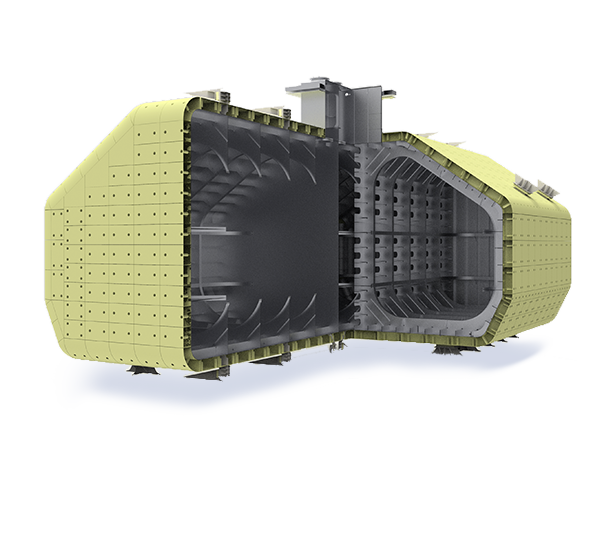
Torgy LNG delivers innovative solutions for fuel systems
1. Experience with LNG re-gas and fuel handling for marine since 2008
2. Systems are compact, efficient and are currently being installed and commissioned on vessels in China
3. Designed and engineered in Norway
4. European components from reputable partners
5. Extended warranty of the FGSS:2 years from vessel delivery
6. Remote access to FGSS control system
7. One-year free service and support via
remote connection One-year free service and support via remote connection


OUR GREEN VISION
- Torgy LNG aims to contribute to the reduction of CO2 emissions within the marine sector by offering energy efficient LNG supply and containment systems
- We are constantly developing our offering to cater to market needs and have developed ammonia ready fuel and containment systems for vessels
- Our LNG A tank (and C tank) can be delivered as ammonia ready

OUR DEFINITION OF AMMONIA READY
- Minimum conversion time
- Completely ammonia ready tanks including:
- The tank itself
- FPR / TCS and its equipment
- Pumps within the tank
- Plug and play skids for ammonia conversion
- Ammonia ready piping, enclosures and bunkering systems


AMMONIA PROPERTIES AS FUEL
- NH3 energy density is much lower than LNG -> larger storage capacity, fuel pipes & equipment capacity requirement
- Ammonia as liquid fuel - system comparable to LPG – FGSS
- Ammonia as gas fuel - system comparable to DF set-up
- Safety concerns due to toxic NH3vapour
- Large quantity of pilot fuel (>7 %) required due to poor ignition properties
- Material compatibility issues with commonly used engine components made of nickel & copper alloys
ØFMEA (失效模式和影响分析)
ØHAZID(危害辨识)
ØHAZOP(危害与可操作性分析)
- Single failure shall not prevent safe operation
- Designed to prevent venting under normal
- Requires equipment which are approved to run in gas environment
- Controlled & safe ventilation including vapour collection
- Vent discharge location subject to risk assessment and gas dispersion CFD
- Double barrier against NH3leakage in all enclosed spaces and where human exposure is possible



- Tank Connection Space (TCS)
- 2 x 100 % Delivery Trains inside
the TCS
- 4 DF engines at totally 25200 kW
- High focus on Material Handling

- Tank Connection Box (TCB)
- Bunkering skid (Manifold) for 4 x
ISO containers
- ISO tanks – Pressurized by FGSS
for bunkering

- Fuel Preparation Room (FPR)
- 2 x 100 % BOG Compressors
- Vertical Shell & Tube Fuel
heaters
- Vertical Shell & Tube BOG
Pre-Heaters
- Expansion vessel for WG system –
High point
- Pressure vessel with nitrogen
atmosphere
- Master Fuel Gas Valves

- Bunkering Station
- Very narrow design due to lack of
available space in the semi-enclosed bunkering station.
- Bunkering Rate: 300 m3/h
with DN150 LNG Pipe with Vapour Return (DN100).

- ISO Container Logistic
- Bunkering operations on daily
basis
- Frequent replacement of empty ISO
containers

- Tank Connection Space (TCS)
- 2 x 100 % Delivery Trains inside
the TCS
- 4 DF engines at totally 25200 kW
- High focus on Material Handling

- Tank Connection Box (TCB)
- Bunkering skid (Manifold) for 4 x
ISO containers
- ISO tanks – Pressurized by FGSS
for bunkering

- Fuel Preparation Room (FPR)
- 2 x 100 % BOG Compressors
- Vertical Shell & Tube Fuel
heaters
- Vertical Shell & Tube BOG
Pre-Heaters
- Expansion vessel for WG system –
High point
- Pressure vessel with nitrogen
atmosphere
- Master Fuel Gas Valves

- Bunkering Station
- Very narrow design due to lack of
available space in the semi-enclosed bunkering station.
- Bunkering Rate: 300 m3/h
with DN150 LNG Pipe with Vapour Return (DN100).

- ISO Container Logistic
- Bunkering operations on daily
basis
- Frequent replacement of empty ISO
containers


Shipyard installation ongoing – All items delivered

Commissioning for first vessel in August 2021

Shipyard installation ongoing – All items delivered

Commissioning for first vessel in August 2021
CCS is divided into A tank and B tank.
TORGY USE WELL PROVEN IMO A TANK TECHNOLOGY IN A NEW APPLICATION
1. Well proven LPG
technology-non-pressurized
(0.7barg)
2. Independent tank
type – utilising standard ship construction practices
3. Customizable
shape - ideal for optimising tank capacity
4. Inspection is
possible from all sides of primary barrier
5. Secondary
barrier - unique and patented system is made of thin 304L
material to allow for fast and cost effective installation

Our unique and patented secondary barrier system is made of thin 304L material to allow for fast and cost effective installation.

LNG Fuel Tank


LNG Fuel Tank


LNG Carriers and Bunker Vessels


LNG Carriers and Bunker Vessels


Floating & Land-based LNG Storage, Power Barge & FSRU


Floating & Land-based LNG Storage, Power Barge & FSRU


- Fully metallic gas and liquid tight secondary barrier
- Continuous integrity check of a liquid- and gas-tight secondary barrier, with continuous HC-sniffing in an inerted hold-space
- DNV endorsement

- Easier installation procedure &
material handling
- Secondary barrier integrity can be
checked during installation period
thus shortening installation duration
- Easy repair procedure for secondary
barrier & insulation

- Support legs that do not need
inspection during tank lifetime
- Cold bridge from tank limited due to
ASEPlas material use
1. Up to 98 % loading possible for A-tank
2. A-tanks are more volume efficient as due to unique geometry, it can store 30-40 % more LNG in same cargo space
3.
4.
5.


Material and installation speed

Time-saving several weeks and reliability.
For example welding (installation) speed with laser welding up to 1 m / minute for the secondary barrier.



Ideal for both fuel tanks and short/medium voyages with multiple stops.

Lower weight in medium sizes and for fuel tanks






1. Adopting mature
hybrid panel structure
2. IMO B tank is a
non-pressurized (0.7 barg), prismatic tank, held in position by steel supports
3. Equipped with
anti-sloshing bulkhead, effectively reducing the effects of sloshing and
fatigue
4. There is no
expensive pump tower, the submersible pump is supported by the bottom girders
5. Tank material:
aluminum alloy 5083-O (priority)
6. Dome structure
is near the center of the top, and the piping interface is centralized in it
7. Only partial
secondary barrier required

The main structure and internal
structure of the LNG storage tank are made of aluminum alloy 5083-O (the lowest
design temperature (MDT) is -162℃). And friction
stir welding and MIG welding are adopted for tank fabrication.

The B tank
has a wide range of applications, which can be used on the sea or on the land.
The size of the tank can cover almost all size requirements, from a few hundred
cubic meters to a large storage tank of 60,000 cubic meters. It can be used for
LNG transport ships, LNG bunkering ships, FLNG, FSRU, LNG powered transport
ships, LNG powered ships/barges, and onshore LNG tanks.
Solutions and Application
Scenarios

Upstream of LNG Industry Chain
Land storage tank of liquefaction plant & FLNG
cargo tank


Upstream of LNG Industry Chain
Land storage tank of liquefaction plant & FLNG
cargo tank


Midstream of LNG Industry Chain
LNG carrier cargo containment system


Midstream of LNG Industry Chain
LNG carrier cargo containment system


Downstream of the LNG Industry Chain
LNG bunkering ship cargo tank, LNG powered ship
fuel tank


Downstream of the LNG Industry Chain
LNG bunkering ship cargo tank, LNG powered ship
fuel tank

Compared with the

Comparison A, B, C and membrane tank types

1. Shell welded by friction stir welding, a method applied in aero space technology
2. Lower welding temperature and lower heat input are required
3. Single pass welding can weld aluminum alloy materials with a thickness of 0.8~100mm; double pass welding can weld 180mm thick butt plates
4. It has incomparable advantages in mechanical properties and construction efficiency
5. Fatigue properties are generally better than those of fusion welded joints
6. No additional weight is added
7. Less welding defects


- Improve accuracy, quality and reliability of construction
- Tank and hull can be built simultaneously, which greatly shortens the construction period

With anti-sloshing structure
NO loading limitation
Membrane type tanks can only load > 90% or < 10%

- Almost equivalent to the membrane type
- Volume utilization ratio is much higher than that of spherical tank (more than 40 %)

Plate thickness is~20 mm - hard to be destroyed.

- Light weight
- Low construction cost

Application of FSW welding technology

- New composite materials
- Effectively reduce stress concentration

- Support structure is at the bottom of tank bottom
- Simple connection structure with tank body
- Excellent insulation and heat preservation effect

- Replace the laminated wood
- Improve stress resistance
- Improved shear strength
- Has been applied to onshore vehicle LNG tanks

Invented different leak
collection systems combining different forms of insulation.

Flexible design and layout

Intelligent control

Commercial

Reliable quality

Low operation and maintenance costs

Fast global service
response speed

Flexible design and layout

Intelligent control

Commercial

Reliable quality

Low operation and maintenance costs

Fast global service
response speed

